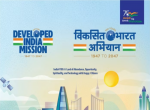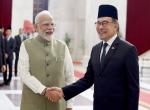Under Article 326 of the Constitution elections to Parliament and to the Legislative Assemblies is on the basis of adult suffrage and any citizen of India who is not less than eighteen years of age or is not otherwise disqualified under the Constitution or under any law on the grounds of non-residence, unsoundness of mind, criminal or corrupt or illegal practice is entitled to be registered as a voter and to cast his vote in an election. There are no educational or other qualifications prescribed for this purpose. The electorate then consists of every Indian of any gender who is eighteen years of age and is not otherwise disbarred by law. This makes the Indian electorate perhaps the largest in the world in numbers. Part XV of the Constitution creates a completely independent, non-partisan Election Commission in which superintendence, direction and control of elections are vested. Under Article 324 (6) the entire machinery of the State which is in any way connected with elections is made available to the Election Commission and to all intent and purpose a major part of the executive machinery of the State functions under the Commission once elections are announced. The Representation of the People Act, 1951, enacted under Article 327, lays down in detail the legal provisions regarding the conduct of elections. Under Article 329 an election to Parliament or the Legislature cannot be called into question by a court of law and can only be challenged by an election petition presented to the authority designated to hear such petitions as per the provisions of law.
From time to time the Election Commission has expanded its role in the conduct of elections. The Representation of the People Act, 1951 states how elections are to be conducted and the powers of the Election Commission and the officers conducting the elections in this behalf. The Act also defines corrupt practices and electoral offences. What the Election Commission has done is to prepare a Model Code of Conduct which takes into account the dos and don’ts given in the Representation of the People Act, 1951 and then monitors the various political parties and individuals standing for election in the matter of observance of the Model Code of Conduct. Specifically the Election Commission places a ban on government taking policy decisions during the period of election, it imposes restrictions on making announcements regarding sops to be offered or benefits made available to the electorate as an inducement to vote for a particular candidate or party, a blanket ban on transfer of officers except as directed by the Commission, prohibits the flaunting of symbols or giving any other sign which might unduly influence the voters, reinforces the legal restrictions on expenditure, place restrictions on use of transport and severely monitors expenditure on elections. The Commission has gone even further to the extent of directing that certain persons will not campaign in a particular constituency and it has ensured that the government machinery cannot be misused in order to favour a particular party or candidate. The Model Code of Conduct, however, has not been framed under any specific provision of law and one wonders what would happen if a candidate or a party defies the Model Code of Conduct. As far as one can see the maximum that the Commission can do if there is violation of the Code of Conduct is to adjourn a poll under section 57 of the Representation of the People Act, 1951 or, order fresh poll under Article 58, or countermand an election under section 58 A of Representation of the People Act, 1951. At worst the Commission can withdraw the notification of general election issued under Part III of the Representation of the People Act, 1951. This would, of course, be an extreme step and it is doubtful whether the Election Commission would ever resort to it.
What we need is codification of the Code of Conduct, with penalties being attached to violations. Such codification may be done by suitable additions to the Representation of the People Act, 1951, giving the Election Commission a sufficiency of legal powers to issue necessary directions for proper conduct of elections and arming it with coercive authority to enforce its orders. The details can be worked out when preparing the draft for amendment of the Act.
We can divide elections into two parts. The first is the process of holding elections and electing parliamentarians and state legislators. Under Articles 83 and 172 of the Constitution the duration of the House of the People and Legislative Assembly of each State will be five years from the date appointed for the first meeting of the House and on expiry of the five-year period the House in question will stand dissolved. Under Articles 83 and 172 neither the Council of States nor the Legislative Council of a State with a bicameral legislature is subject to dissolution, but as nearly as may be one-third of the members of the Council of States and the Legislative Council will retire every second year. In other words, whereas a member of the House of the People or the Legislative Assembly will have a term of five years, unless the House is dissolved earlier, a member of the Council of States and the Legislative Council will normally have a term of six years. The life of the Lower House being five years or less if dissolved earlier, it is mandatory to hold elections prior to the expiry of this five-year period. Under the Representation of the People Act the process of election begins with a notification issued under Part III of the Act, section 12 governing election to the Council of States, section 14 governing election to the House of the People, section 15 governing election to the State Legislative Assembly and section 16 dealing with election to a State Legislative Council. These notifications are issued by the President on the recommendation of the Election Commission for election to Parliament and by the Governor of the State concerned, again on recommendation of the Election Commission, for election to a State Legislature. Such notification begins the process of election and transfers superintendence, direction and control over the process to the Election Commission. Part IV of the Representation of the People Act, 1951 prescribes the administrative machinery for the conduct of elections and such machinery is firmly under the control of the Election Commission.
Once the notification for general election is issued the Election Commission will proceed under Part V of the Act to conduct the election. By notification the Commission prescribes dates for presenting nominations of candidature, making of deposits for the purpose of nomination, scrutiny of nominations and their acceptance or rejection, withdrawal of candidature, etc. Everything consequential to filing a nomination and its acceptance is provided for in the Representation of the People Act, 1951. Sections 56 to 63 govern the poll proper, including casting of votes, just as sections 64 to 67 refer to counting of votes and declaration of results. Because this process is totally within the ambit of the Election Commission its powers are very clear and successive Chief Election Commissioners have tried to make the process clean, impartial, electorate-friendly, safe and open to public scrutiny. A Chief Election Commissioner such as N. Gopalaswamy was able to conduct absolutely clean elections even in militancy and separatist affected Jammu & Kashmir, insurgency hit North-Eastern States, lawless Bihar and even West Bengal where Marxist rule had virtually made the State a pocket borough of the Left Front. By deployment of Central Police Forces or Police from other States, by ensuring that sensitive booths had polling officials from outside the district, region or state, by universal use of tamper proof electronic voting machines the Election Commission has done us proud in establishing the credibility of our electoral system. We need to support the Election Commission in further strengthening the system, but by and large we are on the right track here.
However, there are certain areas where the system needs change. In a parliamentary democracy it is essential that there should be strong political parties with defined ideologies and programmes of their own. Ideally a two-party system in which both parties agree on fundamentals and disagree on details would be ideal. The Republic and Democratic Parties of the United States and, till fairly recently, the Labour and Conservative Parties in the United Kingdom are good examples of the two-party system. In Germany, on the other hand, there are three major parties with a centrist party, a right of centre party and a left of centre party. The Greens, who stand for total environmental protection, come somewhere between the centrist and left of centre parties. However, Germany has fairly stable coalitions because the parties which come together on a common platform have viability of their own and, therefore, their general behavior within government is both rational and reasonable. India virtually had a one-party system with the Congress dominating, but from 1967 onwards the system started facing major changes. The Bharatiya Janata Paty (BJP) started emerging on the national scene and its partnership with United Front Governments in the States from 1967 onwards and its major partnership in the Janata Government between 1977 and 1980 gave strength to the party. Its political platform is right of centre, but its ideology is largely influenced by RSS and a sort of grounding in a philosophy in which Hindu beliefs dominate. For a while it appeared that the Left would play a major all India role in politics, but unfortunately it never grew out of its moorings in West Bengal and Kerala and it painted itself into an irrelevant corner when it withdrew support from the UPA Government over the nuclear agreement issue. In the election which brought UPA II to power the Left lost a majority of its seats in Parliament and in the West Bengal and Kerala elections in 2011 it lost its majority in the State Legislatures. However, the disturbing element is that a number of regional parties, whose vision is restricted to the narrow region from which each of them comes, have been able to make their presence felt in Parliament and, because the BJP and Congress do not each individually occupy a sufficiency of seats in the House to be able to form a government of their own, there have been highly unstable coalitions or, rather, volatile coalitions by both BJP and Congress with a large number of regional groups. This reduces the room for manoeuvre of the lead party in the coalition and leaves it at the mercy of the regional parties. Such a coalition is unable to govern firmly and effectively for the fulfillment of a predetermined agenda or programme or ideology. The very nadir of such coalition was reached when the Prime Minister virtually succumbed to the pressure of coalition partners such as DMK and gave a very long rope indeed to ministers representing a particular party to run their departments according to their own whims, even if it resulted in extreme corruption. In other words, such coalitions under Indian conditions invariably lead to blackmail of the dominant partner by the various regional partners of the coalition.
We have to bring about electoral reforms which can stop such blackmail. We have to bring about political reforms which encourage parties to coalesce and form viable national parties or groups. These reforms could take the following shape:-
- We have to ensure that only very serious independent candidates who have demonstrated their genuine desire to participate in the political process should be allowed to contest elections. Therefore, no independent should be eligible for nomination as a candidate for a State Assembly election unless he has first won a local government election, whether it be to a panchayat or a municipality. No independent should be qualified to stand for election to Parliament unless he has passed through the twin process of winning a local government election and a State Assembly election. This would eliminate a major part of the independents that now plague the electoral scene.
- There should be a blanket ban on any party fielding candidates for election to Parliament unless it has won at least five seats each in three State Legislatures. For DMK or AIADMK to offer candidates for election to Parliament they would first have to expand their base into at least two neighbouring States and successfully contest elections there. Now the choice before regional parties would be either to merge with larger national parties, or to expand their base to cover at least three States. This would on the one hand strengthen the national parties and on the other prevent splinter groups from forming a caucus within Parliament designed to extract its pound of flesh in exchange for supporting the ruling coalition. Now we can have majority governments of a single party or a strong coalition where there is some commonality of ideology between the coalition partners, freeing them of the need to make compromises in order to appease smaller parties. It is my submission that this reform would cleanse our politics quite substantially.
- Then there is the issue of money. Elections are expensive, even completely honest elections where there is not even a hint of bribery by the candidate. A Parliamentary Constituency in India covers a huge territorial area, anywhere between eight thousand and ten thousand kilometres in nonmetropolitan areas. It covers over ten lakh voters. Even a State Legislative Assembly Constituency is large, perhaps larger than a Parliamentary Constituency in Britain, it covers a territorial area of several hundred square kilometres and has over one lakh voters. The candidate needs vehicles to travel around his constituency and he needs assistants who will both canvass for him and provide for his constituency level and sub-regional level offices. A Parliamentary Constituency generally covers about eight Legislative Assembly Constituencies. If one vehicle were deployed for each assembly segment that would make a minimum of eight vehicles which can go cross country. The candidate himself would need one vehicle, his election agent would need one vehicle and there would have to be one or two standby vehicles. Let us put the number of vehicles at twelve per Parliamentary Constituency. For a Legislative Assembly election there would have to be about four vehicles per constituency per candidate. The vehicles would need a driver each, necessary PDOL (petrol, diesel, oil and lubricants) some amount to cover wear and tear and necessary running repairs. The suggestion, therefore, is that for every candidate whose nomination is accepted this is the number of vehicles which must be provide to him at State cost, including the cost of running the vehicles. This number of vehicles should be made available for a period of six weeks from the date of nomination.
In addition a candidate would need a sum of money for covering incidental expenses. Let us keep this at Rs. 10 lakh per Parliamentary Constituency and Rs. 1.5 lakh per State Legislative Assembly Constituency. In addition for the day of the poll each candidate must be given Rs. 250 per polling agent at the rate of two agents per polling booth. This would cover the incidental expenses of polling agents. This should be taken as a part of State funding of elections. Now the Election Commission must very rigidly monitor the expenditure by the candidate, deployment of vehicles, etc., with State funding and the candidates own funds falling within the overall limit per constituency which may be prescribed. The monitoring should be a continuous process and any violation of norms must invite immediate disqualification of the candidate by the Election Commission or, under its direction, the returning officer of the constituency. A candidate who during the course of canvassing violates expenditure norms would then find himself debarred from the poll. What is more, any money spent by the State on providing him facilities should be recovered from the candidate, together with penalty. This should discourage the open bribery by candidates of the voters, which is witnessed in many constituencies at present.
- There are two more areas where we need electoral reforms. The first relates to an elected person changing his party after election, regardless of whether he does it himself or is removed from the party as a part of internal disciplinary proceedings. A person who is elected on a party ticket would lose his seat automatically if he changes his loyalty. The only exception would be that any independent, after election, can announce his political affiliation to a particular party, but once he does so if he changes his mind at any stage he will lose his seat. A person who is removed on account of defection or change of party should be debarred from the election for next six years.
- The second reform in this behalf is that the voter should be given the right to reject every candidate. If the total number of persons who reject all candidates register the highest number of votes in a constituency, the election should be countermanded, all the candidates debarred from elections for the next six years and the parties who put up candidates should be made to equally share the cost of holding fresh polls. This would be a penalty imposed on them and, perhaps, force them to carefully select their candidates with a view to acceptability within the constituency. If the candidate is basically acceptable locally he would have to spend much less on his own campaign because people would already know him and this would certainly cleanse the electoral process.
The Constitution is fine and the Westminster form of government is, perhaps, the best for India under the present circumstances. Our Election Commission has shown us that even within the existing limitations we can conduct fair and impartial elections. If we could muster courage and bring about the kind of electoral reforms suggested in this paper we could certainly make our democracy more worthwhile, more efficient, more effective and more people-friendly.
Published Date : 22nd February 2012









Post new comment